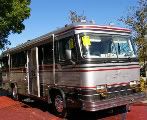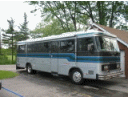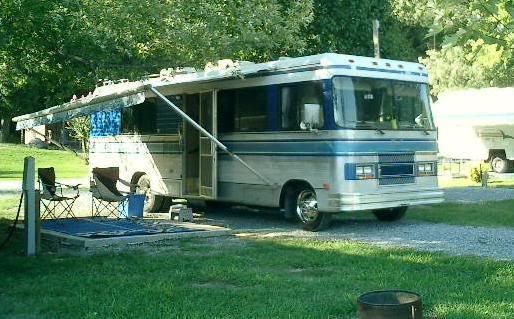Page 1 2
Go to...  | Start A New Topic  | Search  | Notify  | Tools  | Reply To This Topic  |  |
 1/11 1/11 |
How often should you change oil in a cummins 8.3? Should you change filters at the same time? we have 6000 miles on it now her now. thanks lenny all greased up now lenny and judy 32', Regency, Cummins 8.3L, Spartan Chassis, 1992 Tag# 9112 0158 32RS 1B | ||
|
 |
Hi Lenny My 1990 Cummins manual says every 5k miles. Newer engines have much longer change intervals suggested by the manufacturer. There is all kinds of chat on the web about how this interval is affected by ulsd, diesel additives, how often and the type of driving you do and even climate factors. I've gone longer because it wasn't convenient to get a change done at the mileage interval. Don 1990 Regency 34' Cummins 6CTA 8.3 240hp Spartan Chassis, 4 speed Allison MT643 | |||
|
 1/11 1/11 |
Thanks Don I think I will change it after the gtg in Dec. Do you change filters also which ones? lenny and judy 32', Regency, Cummins 8.3L, Spartan Chassis, 1992 Tag# 9112 0158 32RS 1B | |||
|
Don't know what the change interval is on a cummins, depends on what type of oil you are running. However just keep in mind that oil and filters are very cheap compared to the cost of an engine. | ||||
|
 1/11 1/11 |
I under stand about the oil filter.I also have a fuel filter water filter,tranny filter pus a few more that I have.I think I have two oil filters, thanks for the input.I use Rotella-t lenny lenny and judy 32', Regency, Cummins 8.3L, Spartan Chassis, 1992 Tag# 9112 0158 32RS 1B | |||
|
 3/11 3/11 |
For diesels the procedure for fluid changes is based on hours of operation (thus the Hobbs meter) and the general interval is 200 hours. Cummins has an owners manual that applies to each of its engine families. If you don't have one any Cummins Service Center can give you all the information. 1993 32' Regency Wide Body, 4 speed Allison Trans, Front Entry door, Diamond Plate aluminum roof & 1981 Euro 22' w Chevy 350 engine and TH 400 tranny | |||
|
 |
On review, I logged on to Cummins Quickserve Online and put in my engine serial number and they recommend an oil and filter change at 6k miles. My old owner book that came with the Barth says every 5k. It has a fleetguard filter on it. Why not register and see what they say about your engine. It will tell you where and when it was built, plus other stuff and you can download part or all of the maintenance handbook. Don https://quickserve.cummins.com/info/index.html 1990 Regency 34' Cummins 6CTA 8.3 240hp Spartan Chassis, 4 speed Allison MT643 | |||
|
Captain Doom |
When an engine's running under normal loads at operating temperature, very little diminishment of the additive package occurs, and it is depletion of the additives that occasion the need for a change. Large capacities allow longer intervals. Sulfur is the main culprit in depleting the additives and the main cause of problems unneutralized; USLD - in practical terms - should allow longer change intervals, but don't expect engine manufacturers to risk recommending them. In any event, somewhere I heard, "Oil's cheaper than metal." Rusty '94 28' Breakaway: MilSpec AMG 6.5L TD 230HP Nelson and Chester, not-spoiled Golden Retrievers Sometimes I think we're alone in the universe, and sometimes I think we're not. In either case the idea is quite staggering. - Arthur C. Clarke It was a woman who drove me to drink, and I've been searching thirty years to find her and thank her - W. C. Fields | |||
|
 6/12 6/12Formally known as "Humbojb"  |
I wonder if motor homes that are not used very much, like less than 5000 miles a year, should have their oil changed every year regardless of how many miles you've driven? Especially those that sit unused for several months during the winter. I change mine each spring before I start using it. Even if I only drove it two thousand miles. Some might say it's a waste of money but it just seems to me that oil sitting around in a sump for 6 months is not a good thing. Of course, you should take the rig out for a spin, maybe an hour, each month regardless. Jim
| ||||||||||||
|
| First Month Member |
That is also very good for the tires. Tires hate to sit. . 84 30T PeeThirty-Something, 502 powered | |||
|
| First Month Member |
There are also other factors that contribute to an engine being happier when running under normal loads at operating temperature. I had an instructor who was a retired engineer for Wright Aeronautical Engines. His aviation experience went back to WWI and castor oil in the Gnome et Rhône engines, and he had licenses signed by one of the Wright Brothers. He said "90% of engine wear occurs or is the result of cold startups", and cited wonderful advantages of warm oil on cold days. I believe much of his experience predated additive packages. Not real sure, though. He said the combination of poorer circulation, cold temps, oil dilution and oil pollution by combustion byproducts was death on engines. Since he mentioned oil dilution by rich starting mixtures, I asked him about intentional oil dilution (for thinning)in the Arctic. He used a number of expletives in his response. He was a bit of a troglodyte on multiple viscosity oil in aircraft radial engines. It would be interesting to talk to him today, now that multigrade oil is so much better. I'm going to go out on a limb here, and say that recip engine engineering hit its peak during and after WWII. The military and the airlines used radial engines to their utmost, and there were lots of failures to study and learn from. They were working with engines designed a decade earlier, and constantly refined and improved them. It's too bad petroleum engineering had not advanced as far then. In the early years of my airline employment, I observed a stunning difference between the older recip engineers and their jet counterparts. So also did a classmate who worked as an engineer for Patt&Whitney. Our recip mechanics were also more into the soul of an engine than the jet mechanics..................... OH, OH, this is turning into the ramblings of an old man. There is a bumper sticker out there that says, "Real Airplanes Have Two Wings and Round Engines"  Getting back to the here and now, a number of auto manufacturers are equipping their cars with computers that analyze the usage to compute when the oil needs to be changed. Running under normal loads at operating temperature extends the oil change interval. I am sure their algorithm addresses both mechanical considerations and additive depletion. I see the day when cars, or at least OTR trucks engines have onboard oil analyzers. Actually, cars need it more, since their operating conditions are all over the map, compared to trucks. . 84 30T PeeThirty-Something, 502 powered | |||
|
Captain Doom |
He's absolutely right, except that cold starting wear improvements by heating the oil is an old wi--, er, fallacy - heating the oil reduces the viscosity and allows it to run off the parts. Pressurizing the oil system before starting does minimize wear. Anyway, it's the temperature of the engine components that contribute to wear, not the oil temps... BTW, believe it or not, castor oil is the Gold Standard by which any oil's lubricating properties are measured. Fuel dilution in the crankcase is pretty rare, and in any event only applied to diesels (gasoline will evaporate). The most susceptible time for fuel dilution is, you guessed it, cold starts (exceptions are air-cooled aircraft recips, which use the rich fuel mixture to contribute to cooling on takeoff). This is why a diesel-powered vehicle should GO as soon as all cylinders are firing. Sadly air-dependent coaches don't allow that, but as soon as the shifter allows going into gear, do it - the torque converter will put a bit of a load on until the air is up to minimums. Then drive conservatively until near operating temps. At RV parks "convenient" to the main highway, I may take a lap around the park to warm up before I may have to accelerate onto the main. Back to the initial concept: OTR tractors typically run >24,000 miles between changes, mainly because they spend their days running under load. Local cartage tractors may change at 1/2 or less that mileage, due to stopping and idling, and usually parking overnight.
You have the concept right, but the chronology reversed. Oil should be changed BEFORE the winter layup, so that contaminates don't sit in the crancase for months. After that change, the engine should be run at least 10 miles, then parked. Rusty '94 28' Breakaway: MilSpec AMG 6.5L TD 230HP Nelson and Chester, not-spoiled Golden Retrievers Sometimes I think we're alone in the universe, and sometimes I think we're not. In either case the idea is quite staggering. - Arthur C. Clarke It was a woman who drove me to drink, and I've been searching thirty years to find her and thank her - W. C. Fields | |||
|
| The Old Man and No Barth |
I'm with the round engine, two wing contingent. | |||
|
Captain Doom |
I subscribe to the theory that the designers should just decide where to put the wing, rather than just do both But then, my Beechcraft had two - a left and a right - but a flat engine... Rusty '94 28' Breakaway: MilSpec AMG 6.5L TD 230HP Nelson and Chester, not-spoiled Golden Retrievers Sometimes I think we're alone in the universe, and sometimes I think we're not. In either case the idea is quite staggering. - Arthur C. Clarke It was a woman who drove me to drink, and I've been searching thirty years to find her and thank her - W. C. Fields | |||
|
I have a block heater that i plug in for a couple of hours if it is less than 50 degrees outside. | ||||
|
| Powered by Social Strata | Page 1 2 |
| Please Wait. Your request is being processed... |
|
This website is dedicated to the Barth Custom Coach, their owners and those who admire this American made, quality crafted, motor coach.
We are committed to the history, preservation and restoration of the Barth Custom Coach.
We are committed to the history, preservation and restoration of the Barth Custom Coach.



